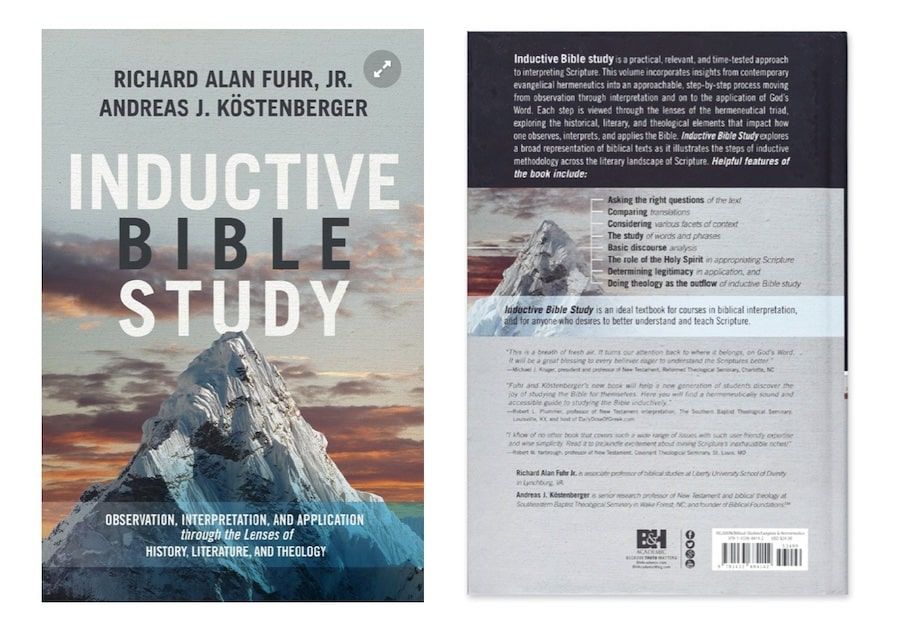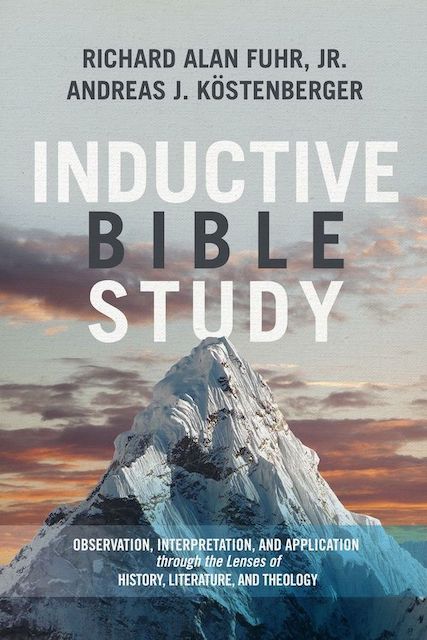Inductive Bible Study
Inductive Bible Study, written by Richard Alan Fuhr Jr. and Andreas J. Kostenberger, serves as a guide to how to study the Bible inductively.

Many pastors and Bible teachers are trained to study the Bible in its original language. They may have attended Bible college or seminary to learn the process of Bible exegesis. But most of us will learn how to study the Bible through our local church or reading a book.
Inductive Bible Study, written by Richard Alan Fuhr Jr. and Andreas J. Kostenberger, is a book that serves as a guide to many of us on how to study the Bible inductively.
1. Purpose of Inductive Bible Study
The authors wrote Inductive Bible Study to provide an academically sound Bible study method that incorporates proper hermeneutics. The foundation of this method is the hermeneutic triad presented in Kostenberger’s 2011 book, Invitation to Biblical Interpretation: Exploring the Hermeneutical Triad of History, Literature, and Theology.
The inductive Bible study method is presented as a list of individual steps through the three primary steps of observation, interpretation, and application.
2. Content of Inductive Bible Study
This textbook is divided into four major units.
The first major unit (Chapters 1 and 2) introduces the challenges modern readers face when studying the Bible and an overview of the inductive Bible study method.
- Chapter 1 identifies eight gaps that must be bridged in Bible study: the time gap, the geographical gap, the cultural gap, the language gap, the literary gap, the supernatural gap, the theological gap, and the appropriation gap.
- Chapter 2 defines seven principles that should be followed when studying Scripture: the literal principle, the contextual principle, the one-meaning principle, the exegetical principle, the linguistic principle, the progressive principle, and the harmony principle. A definition and comparison of an inductive method (evidence-based) and deductive method (assumptions-based) is given. After an overview of the three major steps of inductive Bible study are reviewed, five reasons in favor on an inductive Bible study method are presented.
The second major unit (Chapters 3 to 7) unpack the five principle steps of observation.
- Chapter 3 covers how the modern reader should make important observations by reading and comparing the different modern translations. Translators make exegetical decisions and employ various methods (word-for-word vs. thought-for-thought) in their translation. Translators must also make textual criticism decisions. Understanding these decisions are important in aiding our observation of the text.
- Chapter 4 reviews important questions that modern readers should ask when studying the Bible: content questions (substance of text and significance of content), relationship questions (relationship of words, phrases, and concepts within and between literary units), intention questions (authorial intention), and implication questions (implication and ramification of the interpretation). The author looks at several sample texts and offers examples of good questions. Ten specific practical suggestions are also given to help the reader ask better questions when reading the text.
- Chapter 5 explores words that should be examined further: contextually crucial terms, theologically profound terms, historically particular terms, exegetically or textually uncertain terms, figurative terms, and symbolic terms. Terms that appear more significant warrants more thought regarding its background and meaning.
- Chapter 6 discusses literary features and their significance. Features include repetition (words, phrases, and concepts used more than once in a passage), escalation (line of argument builds to a climax), contrast and comparison (words, phrases, and concepts are juxtaposed against something else), association (words, phrases, and motifs relate to another by association), questions and answer (questions are used to frame an argument), conjunctions (words that direct discourse flow), conditional clauses, illustrations, quotations, and irony. A review of different parallelisms used in the Bible is also given.
- Chapter 7 provides an introduction to discourse analysis. The authors describe structural analysis by defining four aspects: boundary features, structural formulas, cohesion, and relationship. The goal of this type of analysis is similar to that achieved with sentence diagramming and phrasing.
The third major unit (Chapters 8 to 12) explore how to analyze and interpret the data collected from the steps of the previous five chapters.
- Chapter 8 emphasizes the importance of understanding the historical, the literary, and the theological context. Historical context includes the background situation, culture, and geopolitics. Literary context includes the literary genre, the immediate surrounding text, and the context of the entire book and the entire Bible. Theological context examines the larger motifs, the theological covenants, and the progressive revelation-historical context.
- Chapter 9 instructs how the modern reader should comparing one part of Scripture with another. The principle is to interpret Scripture with other Scripture. How to connect and correlate passages within the Bible is important in this interpretative step.
- Chapter 10 explains the mechanics of word study: discover original word behind the translation, discover the semantic range of the word, and discern what the word means based on its context. Common pitfalls and word study fallacies are reviewed, and an overview of word study reference tools are given.
- Chapter 11 takes a small detour from an expository, verse by verse approach. Instead, guidelines to topical Bible study are reviewed. Once a particular theme or motif is identified for a passage, a synthesis of meaning with other passages that correspond to the theme is applied.
- Chapter 12 introduces the use of Bible commentaries. Commentaries can help the reader bridge the historical (time, geography and culture), literary (language and literary genre) and theological gaps. Suggestions on how to select and use commentaries are reviewed. Other resources like study Bibles, Bible atlases, Bible introductions, and journal articles are also discussed.
The fourth major unit (Chapters 13 to 15) reviews the process on how to apply the ancient biblical text and make the Bible relevant the Christian life today.
- Chapter 13 begins the discussion on how the reader can transition from interpretation to application. The authors reviews how the hermeneutical triad affects our approach to application. Five steps are suggested in this important process: (1) Discover how the original author intended his original audience to apply the text, (2) separate “knowing” texts and “doing” texts, (3) identify the principles of the text, (4) define boundaries on what the text can and cannot mean, and (5) develop scenarios in which the text can be applied today.
- Chapter 14 reminds the reader of the vital role of the Holy Spirit in granting wisdom to how to apply the Bible. Personal application requires personal assessment, reflective meditation, and finally appropriation.
- Chapter 15 argues that the final goal of inductive Bible study is both knowing and doing God’s word. Having a biblical theology is the result of knowing God’s word, but this newly discovered biblical theology must also compel the reader to action.
3. Commentary of Inductive Bible Study
I found this book to read like a textbook on inductive Bible study. The authors lay the foundation by introducing hermeneutics, the principles that should be followed in Bible study. Then, they walk through the process of Bible study, defining the three steps of observation, interpretation, and application. Fifty to one hundred pages are dedicated to explain how to accomplish each step. Practical examples are given throughout the book after each major explanation.
This book is ideal for all Christians who are serious about wanting to studying the Bible in their modern translation. In the United States, it would be Christians planning to study the Bible through the study of several English translations. The methodology presented is not applicable for Bible teachers who study the Bible through examination of the original text. Other Bible exegesis books would be more suitable.
4. Comparison Analysis
My favorite resource on Bible interpretation for most Christians is the four book How to Read the Bible series published by Zondervan.
- How to Read the Bible for All Its Worth
- How to Read the Bible Book by Book: A Guided Tour
- How to Choose a Translation for All Its Worth
- How to Read the Bible through the Jesus Lens
For Christians just starting to read the Bible regularly, I still suggest the first two books in this series: How to Read the Bible for All Its Worth and How to Read the Bible Book by Book, both written by Gordon D. Fee and Douglas Stuart.
Inductive Bible Study will compliment this material well when the Christian is ready to develop a personal methodology for Bible study. Bible reading precedes Bible study.
This book also contains enough introductory material on hermeneutics for most Christians. But for readers desiring to dig deeper on biblical hermeneutics, this book provides a great bridge to Invitation to Biblical Interpretation, another book written by Kostenberger.
5. Final Thoughts
Fuhr and Kostenberger have succeeded in writing an academically sound textbook on the process of inductive Bible study for Christians desiring to study the Bible using modern Bible translations. Once a Christian has developed a process for Bible reading, a personal method for Bible study should be sought. And this book is my top choice for developing the discipline of personal Bible study.
| Listen on Apple Podcasts | Listen on Google Podcasts |
|---|





